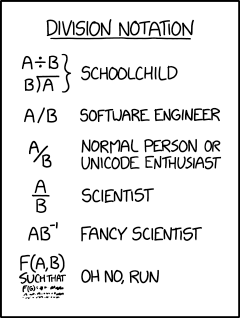
Source: https://xkcd.com/2687/
Explaining the "whys" of mathematics

Source: https://xkcd.com/2687/
From the YouTube description: “There are lots of ways to compare a million to a billion, but most of them use volume. And I think that’s a mistake, because volume just isn’t something the human brain is great at. So instead, here’s the difference between a million and a billion, in a more one-dimensional way: distance.”
The video is more than an hour long, which is the point. In the last minute of the video, he mentions what a trillion would be in the same scenario.
News You Can Use, courtesy of Popular Mechanics: The mathematical ways to most efficiently mow your yard, by shape of yard.
https://www.popularmechanics.com/science/math/a28722621/mow-your-lawn-using-math/
I’m doing something that I should have done a long time ago: collecting a series of posts into one single post. The following links comprised my series poorly written word problem, taken directly from textbooks and other materials from textbook publishers.
Part 1: Addition and estimation.
Part 2: Estimation and rounding.
Part 3: Probability.
Part 4: Subtraction and estimation.
Part 5: Algebra and inequality.
Part 6: Domain and range of a function.
Part 7: Algebra and inequality.
Part 8: Algebra and inequality.
Part 9: Geometric series.
Part 10: Currently infeasible track and field problem.
Part 11: Another currently infeasible track and field problem.
Set a digital clock to display in 24-hour (military) time. Each day, it will show you 211 prime numbers starting with 00:02 (2 minutes after midnight) and ending with 23:57 (3 minutes before the next midnight.)
Oh, and 211 is also prime, so 02:11 would be one of the 211 prime times you observe each day.

Somehow I found this fun website with various teaching resources using different coding and decoding methods: http://www.cimt.org.uk/resources/codes/?fbclid=IwAR2yX_yDK0UAmLB2acIgbk15wJMy_QXFJSuKaQOj3q-SlrFkuuuxpsEXoyI
For math/puzzle enthusiasts (as well for as my own future reference): This was one of the most diabolically difficult puzzles that I’ve ever seen. The object: use the numbers 1-9 exactly once in each row and column while ensuring that the given arithmetical operation in each cage is also correct. Here it is. Fair warning: while most MathDoku+ puzzles take me 20-40 minutes to solve, this one took me over 3 hours (spread out over 5 days).
In the United States, today is abbreviated 10/31. Define the th repunit number as
,
a base-10 number consisting of consecutive 1s. For example,
,
and so on.
It turns out that is the largest known prime repunit number.